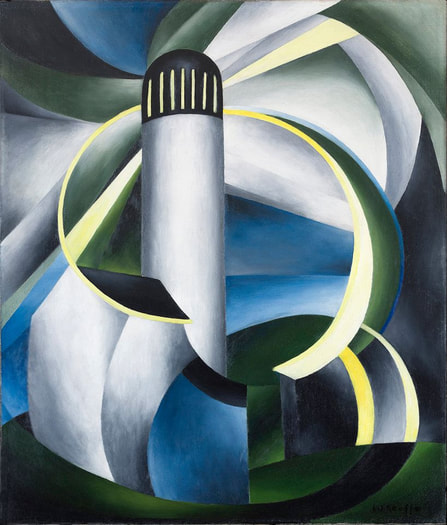|
A Crown for Ida O’Keeffe “Her life and art have only appeared as context for that of her famed sister.” -The Clark Art Institute, “Ida O’Keeffe: Escaping Georgia’s Shadow.” 1. Creation The famous last name nudges you to find a trace of Georgia, and you might—in stark geometry and large blocks well defined by colour—but in Ida’s work a spark of wildness sets its own fire. Bold abstraction subdues her sister’s shadow; shapes collide, their force accumulates, and light and action crowd the space. Sharp edges, multiplied, direct the eye toward a blue and gold and perfect orb of hard-won harmony-- as if a world of difference might uphold a world of peace. Whatever you may see, it’s not a shadow, it’s not imitation; as Ida’s title tells us, it’s creation. 2. Royal Oak of Tennessee As Ida’s title tells us, this creation of soil and sun and time stands regally beneath a southern sky; its domination of earth and air determines what we see. Reducing distant mountains to dull hills, obscuring ripples in a nearby stream, it sprawls both up and out, and more than fills the frame. Its leaves, bright green but blurry, seem to float above the massive trunk and limbs, whose thickly muscled reach commands the eye; more bark than foliage, the grand oak trims the vastness of the heavens. When the sky grows dark, this king of trees stands unafraid-- and blocks from view the crown the stars have made. 3. Star Gazing in Texas A woman’s need to see the stars has made her climb this hill and stretch toward the sky, her body long and thin, her bent arms laid against her skull, her moon-pale chin held high. Her need to see the stars has made men fall, their faces unseen, their feet in the air-- has made them, like the distant horses, small and vague and helpless and just barely there. Her need has made her coal-black dog alert; head cocked, tail straight, he stares out of the frame, while she searches the sky, her milk-white skirt bright as the starlight that she hopes to claim. But need has made the stars unreal: too neat, like children’s drawings. Heaven, too, a cheat. 4. Toadstool Like children’s drawings—though they wouldn’t cheat the eye of colour—this brown painting shows a simple, finite world, a life complete. The solitary toadstool will expose no troubling passion; in its curving stem and speckled head no secrets lie in wait, no subtle mystery that might condemn the random spectator to meditate on meaning. But it’s all so very brown-- from tan to cocoa to mahogany. No sunlight’s penetrated this far down; the toadstool lives beneath a canopy of grander green. Perhaps it does deserve a closer look. Why does this pale stem curve? 5. Still Life with Fruit A close look at this fruit and this pale curve of wall behind it finds a harmony of shapes: the creamy backdrop’s rightward swerve echoes the lean of berries, which agree with arcs of apples. And a rhythm made of colors links the yellows of the vase and apples, like bright whole notes played against leaf green and berry pink. The space has been composed to satisfy the eye, but almost stirs the ear: a mute pavane, a nearly-sung but soundless lullaby, an etude when Chopin’s left the salon. An unseen sun conducts the scene: its gaze lights arcs of calm that hum beneath its rays. 6. Variation on a Lighthouse Theme IV Wild arcs and angles broadcast piercing rays of artificial sun that punctuate a realm they don’t attempt to rule; their blaze of white and yellow means to mitigate the gray and blue. Not warmed by Georgia’s light, her sister coolly trusted her own eyes; her vision proved sufficient to ignite this shining lamp. Defining coastal skies in well-timed intervals, her lighthouse guides and warns the sailor, but won’t save a soul; a lack of wit or will quickly divides the sailor or the artist from his goal, and neither would trust solely in protection that might be offered by a split reflection. 7. Whirl of Life What might be offered in this split reflection-- this half-red, half-black flash of energy-- is up to you. Do you see disconnection between the dark and bright? Or do you see one feed the other? Scarlet swirls invade an inky depth—or that abyss has bred a bloody fury—or the void has made a space for brilliant revels. Or instead you might see flames, or birth, a pulsing heart, a holy moment or one of damnation, two mighty forces wed, or torn apart. What few will see is peace, or resignation, or shadows—those that cast doubt or the kind the famous last name nudges you to find. Jean L. Kreiling Jean L. Kreiling is the author of two collections of poetry: Arts & Letters & Love (2018) and The Truth in Dissonance (2014). Her work has been honoured with the Able Muse Write Prize, the Great Lakes Commonwealth of Letters Sonnet Prize, the Kelsay Books Metrical Poetry Prize, a Laureates’ Prize in the Maria W. Faust Sonnet Contest, three New England Poetry Club prizes, the Plymouth Poetry Contest prize, and the String Poet Prize.
1 Comment
NancyBibbins
5/16/2021 06:58:41 pm
Fascinating reflections aptly expressed!
Reply
Your comment will be posted after it is approved.
Leave a Reply. |
The Ekphrastic Review
COOKIES/PRIVACY
This site uses cookies to deliver your best navigation experience this time and next. Continuing here means you consent to cookies. Thank you. Join us on Facebook:
July 2024
|










